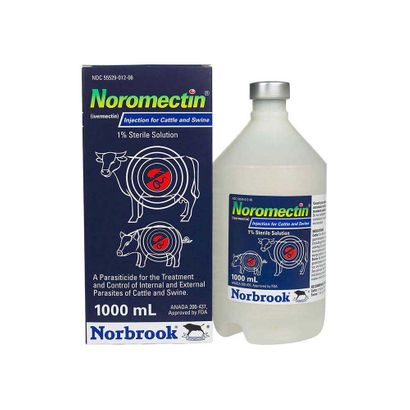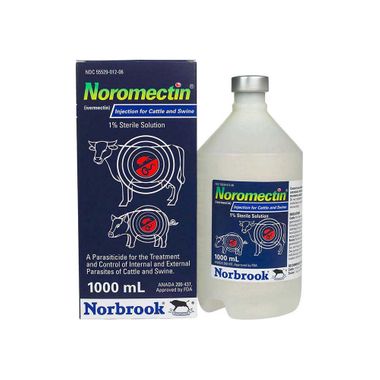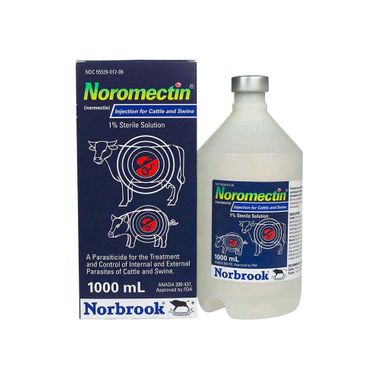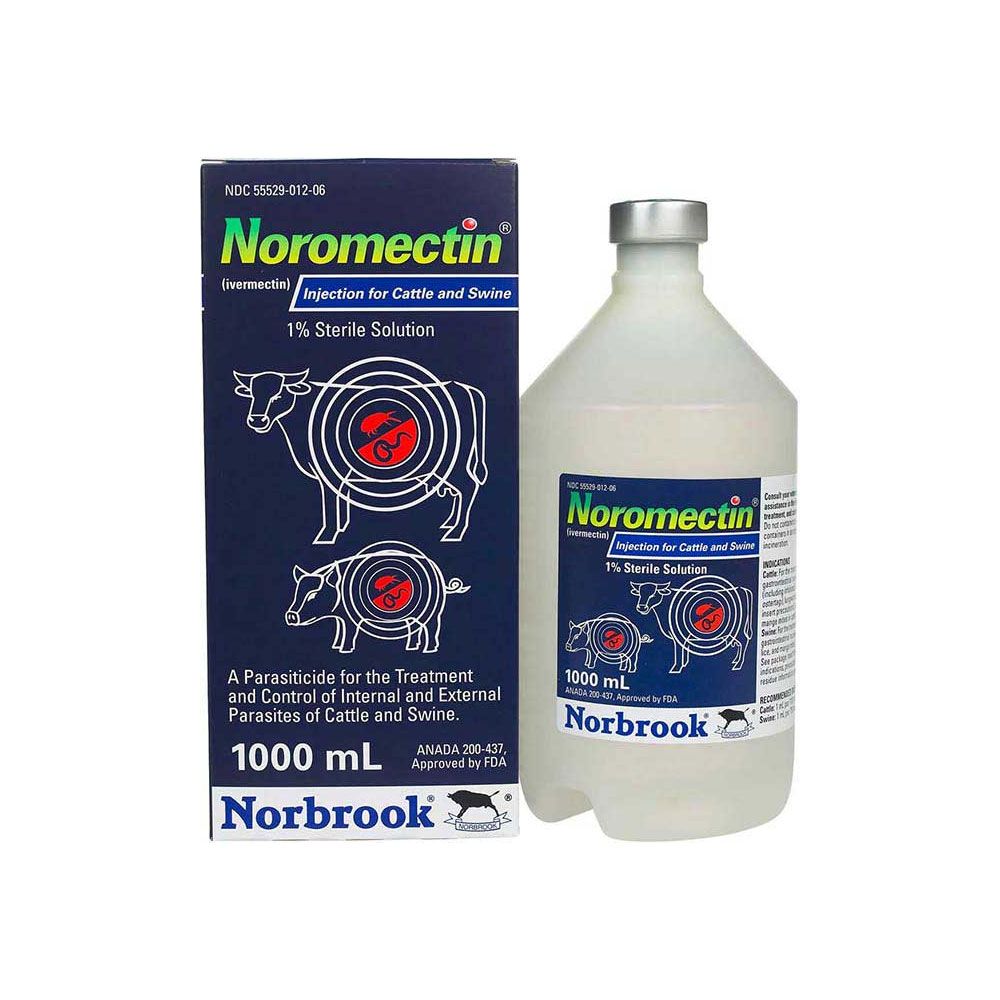SAVE 20% OFF 20% OFF Use Code NY26 *
Noromectin Injection
- Notice
- Description
- Directions
- Reviews
Notices
Description
Noromectin® Injection for Cattle and Swine a unique product for controlling parasites of cattle and pig.
- Injectable dewormer for use in cattle and pigs
- Controls a variety of internal and external parasites
- Contains the active ingredient ivermectin
- 35 day withdrawal in cattle, 18 day withdrawal in swine
- Sterile solution, no mixing required
This injectable bovine and porcine dewormer may be used in beef cattle, dairy cattle and swine to effectively treat and control the following internal and external parasites:
- Gastrointestinal roundworms
- Lungworms
- Grubs
- Sucking lice
- Mange mites
In cattle:
- Gastrointestinal roundworms
- Lungworms
- Lice
- Mange mites
In swine:
Each mL of Noromectin® Injection for Cattle and Swine contains 10 mg of ivermectin, sufficient to treat 110 lb of body weight in cattle or 75 lb or body weight in swine. This product has a 35 day slaughter withdrawal time in cattle, and an 18 day slaughter withdrawal time in swine. Because a withdrawal time in milk has not been established, do not use in female dairy cattle of breeding age. Do not use in calves to be processed for veal.
Directions
Cattle: Noromectin Injection should be given only by subcutaneous injection under the loose skin in front of or behind the shoulder at the recommended dose level of 200 mcg of ivermectin per kilogram of body weight. Each mL of Noromectin Injection contains 10 mg of ivermectin, sufficient to treat 110 lb (50 kg) of body weight (maximum 10 mL per injection site).
| Body Weight (lb) | Dose Volume (mL) |
|---|---|
| 220 | 2 |
| 330 | 3 |
| 440 | 4 |
| 550 | 5 |
| 660 | 6 |
| 770 | 7 |
| 880 | 8 |
| 990 | 9 |
| 1100 | 10 |
Swine: Noromectin Injection should be given only by subcutaneous injection in the neck of swine at the recommended dose level of 300 mcg of ivermectin per kilogram (2.2 lb) of body weight. Each mL of Noromectin Injection contains 10 mg of ivermectin, sufficient to treat 75 lb of body weight.
| Body Weight (lb) | Dose Volume (mL) | |
|---|---|---|
| Growing Pigs | 220 38 75 150 |
1/4 1/2 1 2 |
| Breeding Animals (Sows, Gilts, and Boars) | 225 300 375 450 |
3 4 5 6 |
ADMINISTRATION:
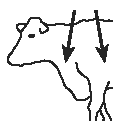 Cattle: Noromectin Injection is to be given subcutaneously only, to reduce risk of potentially fatal clostridial infection of the injection site. Animals should be appropriately restrained to achieve the proper route of administration. Use of a 16-gauge, 1/2 to 3/4 inch needle is suggested. Inject under the loose skin in front of or behind the shoulder (see illustration).
Cattle: Noromectin Injection is to be given subcutaneously only, to reduce risk of potentially fatal clostridial infection of the injection site. Animals should be appropriately restrained to achieve the proper route of administration. Use of a 16-gauge, 1/2 to 3/4 inch needle is suggested. Inject under the loose skin in front of or behind the shoulder (see illustration).
When using the 250, 500 or 1000 mL pack size, use only automatic syringe equipment.
Use sterile equipment and sanitize the injection site by applying a suitable disinfectant. Clean, properly disinfected needles should be used to reduce the potential for injection site infections.
No special handling or protective clothing is necessary.
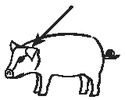 Swine: Noromectin (ivermectin) Injection is to be given subcutaneously in the neck. Animals should be appropriately restrained to achieve the proper route of administration. Use of a 16- or 18-gauge needle is suggested for sows and boars, while an 18- or 20-gauge needle may be appropriate for young animals. Inject under the skin, immediately behind the ear (see illustration).
Swine: Noromectin (ivermectin) Injection is to be given subcutaneously in the neck. Animals should be appropriately restrained to achieve the proper route of administration. Use of a 16- or 18-gauge needle is suggested for sows and boars, while an 18- or 20-gauge needle may be appropriate for young animals. Inject under the skin, immediately behind the ear (see illustration).
When using the 100, 250, 500 or 1000 mL pack size, use only automatic syringe equipment. As with any injection, sterile equipment should be used. The injection site should be cleaned and disinfected with alcohol before injection. The rubber stopper should also be disinfected with alcohol to prevent contamination of the contents. Mild and transient pain reactions may be seen in some swine following subcutaneous administration.
Recommended Treatment Program
Swine: At the time of initiating any parasite control program, it is important to treat all breeding animals in the herd. After the initial treatment, use Noromectin Injection regularly as follows:
BREEDING ANIMALS
Sows: Treat prior to farrowing, preferably 7-14 days before, to minimize infection of piglets.
Gilts: Treat 7-14 days prior to breeding.
Treat 7-14 days prior to farrowing.
Boars: Frequency and need for treatments are dependent upon exposure.
Treat at least two times a year.
FEEDER PIGS
(Weaners/Growers/Finishers)
All weaner/feeder pigs should be treated before placement in clean quarters.
Pigs exposed to contaminated soil or pasture may need retreatment if reinfection occurs.
- Noromectin Injection has a persistent drug level sufficient to control mite infestations throughout the egg to adult life cycle. However, since the ivermectin effect is not immediate, care must be taken to prevent reinfestation from exposure to untreated animals or contaminated facilities. Generally, pigs should not be moved to clean quarters or exposed to uninfested pigs for approximately one week after treatment. Sows should be treated at least one week before farrowing to minimize transfer of mites to newborn baby pigs.
- Louse eggs are unaffected by Noromectin Injection and may require up to three weeks to hatch. Louse infestations developing from hatching eggs may require retreatment.
- Consult a veterinarian for aid in the diagnosis and control of internal and external parasites of swine.
NOTE:
- Reindeer: For the treatment and control of warbles (Oedemagena tarandi) in reindeer, inject 200 micrograms ivermectin per kilogram of body weight, subcutaneously. Follow use directions for cattle as described under ADMINISTRATION.
- American Bison: For the treatment and control of grubs (Hypoderma bovis) in American bison, inject 200 micrograms ivermectin per kilogram of body weight, subcutaneously. Follow use directions for cattle as described under ADMINISTRATION.
Special Minor Use
RESIDUE WARNINGS: Do not treat reindeer or American bison within 8 weeks (56 days) of slaughter.
WARNING
NOT FOR USE IN HUMANS.
Keep this and all drugs out of the reach of children.
The Material Safety Data Sheet (MSDS) contains more detailed occupational safety information. To report adverse effects, obtain an MSDS or for assistance, contact Norbrook toll free 1-866-591-5777.
RESIDUE WARNINGS: Do not treat cattle within 35 days of slaughter. Because a withdrawal time in milk has not been established, do not use in female dairy cattle of breeding age. A withdrawal period has not been established for this product in pre-ruminating calves.
Do not use in calves to be processed for veal.
Do not treat swine within 18 days of slaughter.
PRECAUTIONS
Transitory discomfort has been observed in some cattle following subcutaneous administration. A low incidence of soft tissue swelling at the injection site has been observed. These reactions have disappeared without treatment. For cattle, divide doses greater than 10 mL between two injection sites to reduce occasional discomfort or site reaction.
Use sterile equipment and sanitize the injection site by applying a suitable disinfectant. Clean, properly disinfected needles should be used to reduce the potential for injection site infections.
Observe cattle for injection site reactions. Reactions may be due to clostridial infection and should be aggressively treated with appropriate antibiotics. If injection site infections are suspected, consult your veterinarian.
This product is not for intravenous or intramuscular use. Protect product from light.
Noromectin Injection for Cattle and Swine has been developed specifically for use in cattle, swine, reindeer, and American bison only. This product should not be used in other animal species as severe adverse reactions, including fatalities in dogs, may result.
When to Treat Cattle with Grubs
Noromectin Injection effectively controls all stages of cattle grubs. However, proper timing of treatment is important. For most effective results, cattle should be treated as soon as possible after the end of the heel fly (warble fly) season. Destruction of Hypoderma larvae (cattle grubs) at the period when these grubs are in vital areas may cause undesirable host-parasite reactions including the possibility of fatalities. Killing Hypoderma lineatum when it is in the tissue surrounding the esophagus (gullet) may cause salivation and bloat; killing H. bovis when it is in the vertebral canal may cause staggering or paralysis. These reactions are not specific to treatment with Noromectin Injection, but can occur with any successful treatment of grubs. Cattle should be treated either before or after these stages of grub development. Consult your veterinarian concerning the proper time for treatment.
Cattle treated with Noromectin Injection after the end of the heel fly season may be retreated with Noromectin Injection during the winter for internal parasites, mange mites, or sucking lice without danger of grub-related reactions. A planned parasite control program is recommended.



